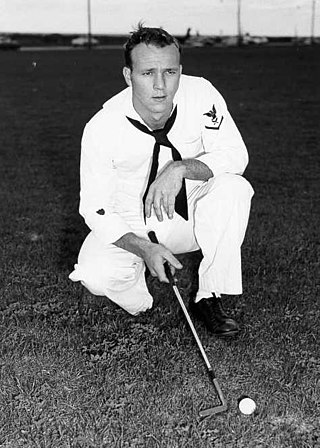
Arnold Daniel Palmer was an American professional golfer who is widely regarded as one of the greatest and most charismatic players in the sport's history. Since embarking on a professional career in 1955, he won numerous events on both the PGA Tour and the circuit now known as PGA Tour Champions. Nicknamed "The King", Palmer was one of golf's most popular stars and seen as a trailblazer, the first superstar of the sport's television age, which began in the 1950s.

Jack William Nicklaus, nicknamed "the Golden Bear", is an American retired professional golfer and golf course designer. He is widely considered to be one of the greatest golfers of all time. He won 117 professional tournaments in his career. Over a quarter-century, he won a record 18 major championships, three more than second-placed Tiger Woods. Nicklaus focused on the major championships—the Masters Tournament, U.S. Open, Open Championship and PGA Championship—and played a selective schedule of regular PGA Tour events. He competed in 164 major tournaments, more than any other player, and finished with 73 PGA Tour victories, third behind Sam Snead (82) and Woods (82).
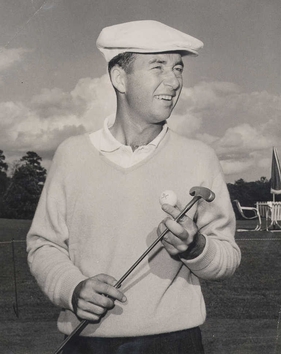
Kenneth Paul Venturi was an American professional golfer and golf broadcaster. In a career shortened by injuries, he won 14 events on the PGA Tour including a major, the U.S. Open in 1964. Shortly before his death in 2013, Venturi was inducted into the World Golf Hall of Fame.
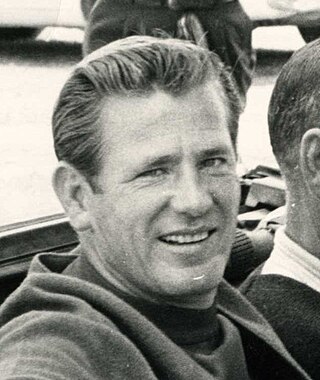
George Douglas Sanders was an American professional golfer who won 20 events on the PGA Tour and had four runner-up finishes at major championships.
Thomas Dean Aaron is an American former professional golfer who was a member of the PGA Tour during the 1960s, 1970s and 1980s. Aaron is best known for winning the 1973 Masters Tournament. He is also known for an error in the 1968 Masters Tournament, when he entered a 4 instead of a 3 on Roberto De Vicenzo's scorecard, which kept De Vicenzo out of a playoff for the tournament.

Arthur Jonathan Wall Jr. was an American professional golfer, best known for winning the Masters Tournament in 1959.
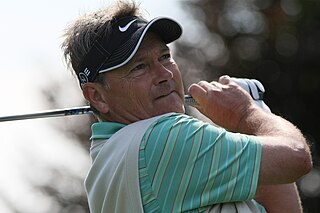
John Neuman Cook is an American professional golfer, who won eleven times on the PGA Tour and was a member of the Ryder Cup team in 1993. He was ranked in the top ten of the Official World Golf Ranking for 45 weeks in 1992 and 1993. Cook currently plays on the PGA Tour Champions and is a studio analyst on Golf Channel.

Frank Richard Stranahan was an American sportsman. He had significant success in both amateur and professional golf. He was ranked number one in his weight class in powerlifting, from 1945 to 1954, and he became known on the golf course and off as the "Toledo strongman" long before the modern game of golf and fitness. After he retired from tournament golf in the early 1960s, he became a prolific long-distance runner, competing in 102 marathons.
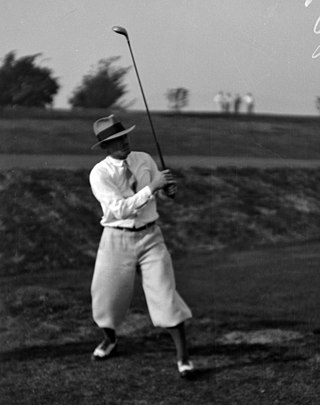
William Earl Mehlhorn was an American professional golfer who played on the PGA Tour in its early days, and was at his best in the 1920s.

Dow Henry Finsterwald, Sr. was an American professional golfer who is best known for winning the 1958 PGA Championship. He won 11 Tour titles between 1955 and 1963, played on four Ryder Cup teams, and served as non-playing captain for the 1977 U.S. Ryder Cup team.
Junius Joseph "Jay" Hebert was an American professional golfer. He won seven times on the PGA Tour including the 1960 PGA Championship. His younger brother, Lionel Hebert, also won the PGA Championship, in 1957, the last edition at match play. Jay played on the 1959 and 1961 Ryder Cup teams and was captain for the 1971 team.
Paul Dye Jr., commonly referred to as Pete Dye, was an American golf course designer and a member of a family of course designers. He was married to fellow designer and amateur champion Alice Dye.

Robert Henry "Skee" Riegel was an American professional golfer.
The Pennsylvania Open Championship is the Pennsylvania state open golf tournament, open to both amateur and professional golfers. It is organized by the Pennsylvania Golf Association. It has been played annually since 1912 at a variety of courses around the state. It was considered a PGA Tour event in some years during the 1920s and 1930s.
Robert Stanton Greenwood, Jr. is an American professional golfer who played on the PGA Tour from 1969 to 1975. He is a PGA of America Life Member.
Judy Kimball Simon is an American professional golfer, best known for winning the LPGA Championship in 1962, a women's major championship.
Richard L. Siderowf is an American amateur golfer, who is best known for winning the British Amateur twice.
The 1926 U.S. Open was the 30th U.S. Open, held July 8–10 at Scioto Country Club in Columbus, Ohio. Noted amateur Bobby Jones, winner of the British Open two weeks earlier, won the second of his four U.S. Opens, one stroke ahead of runner-up Joe Turnesa.
The Ohio Open is the Ohio state open golf tournament, open to both amateur and professional golfers. It is organized by the Northern Ohio section of the PGA of America. It was first played in 1924 and has been played annually at a variety of courses around the state. It was considered a PGA Tour event in the late 1920s and early 1930s.
The Ohio Amateur Championship hosted annually by the Ohio Golf Association (OGA) visits the a variety of courses in the state. The event is open to amateur golfers who are residents of the state of Ohio or attending a state university or college in Ohio. The first OGA event was held at the Cleveland Country Club and has been played annually since 1904 and involves four rounds of stroke play.









